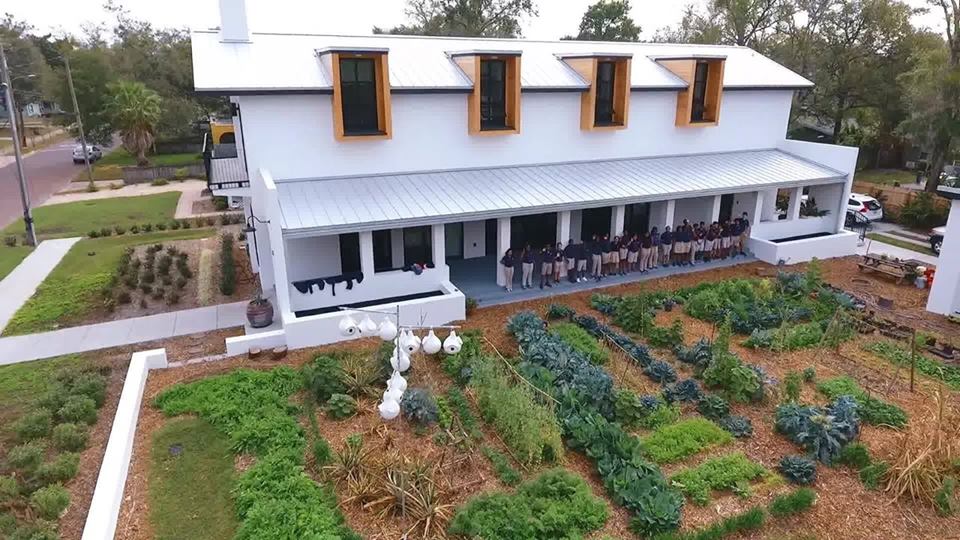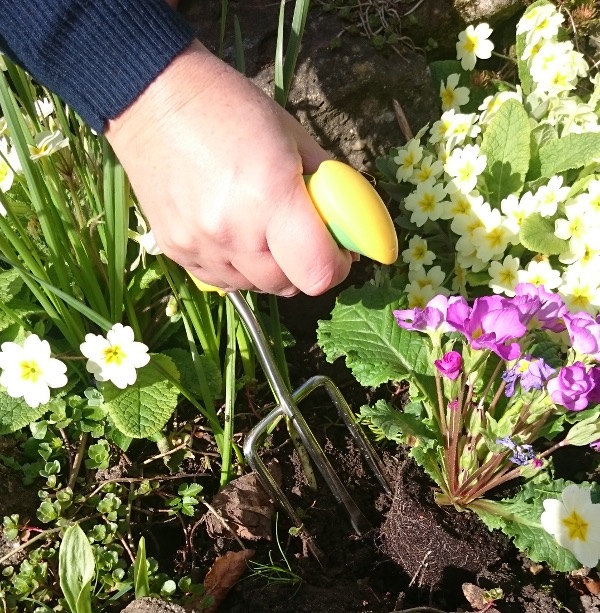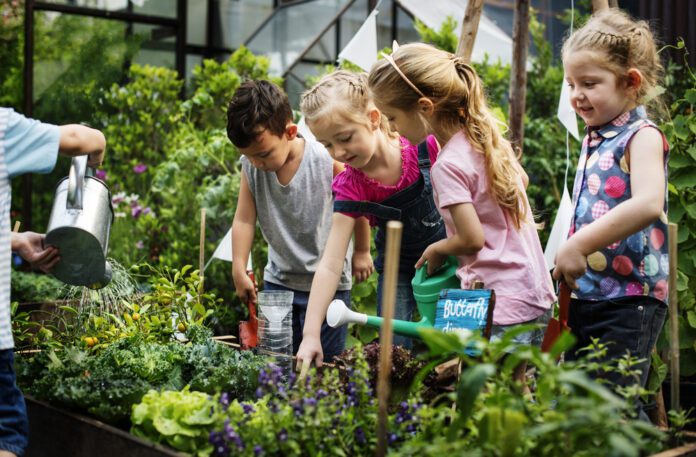Sometimes change in a community begins with asking a simple question. That’s what happened when one parent stepped up to address a need at his child’s school. Back in 2003, the seedling of a simple idea took root at Orlando Junior Academy (OJA) in Orlando, FL. OJA parent Brad Jones helped a first-grade teacher turn a grassy patch into a vegetable garden outside the classroom door.
“When my daughter started learning about nature, she learned the typical icons taught in school: apple trees in the summer and snowflakes and dead branches in the winter,” explains Jones. “But she couldn’t relate to that in Florida. I wondered how teachers could use something right outside the classroom, like an orange tree, to teach Florida students. I started thinking about how to develop a campus that uses nature as a teaching tool.”
Once the project got the green light, Jones began volunteering as garden coordinator, where he helped students plant, grow, and harvest fruit, vegetables, herbs, and even cotton. But now that kids were learning where food comes from, they yearned to know what to do with it. Time to partner with the community.
Student Garden Starts to Bloom
Enter Kevin Fonzo, Chef-Owner of K Restaurant in nearby College Park, and Sarah Cahill, certified raw food chef and holistic nutrition coach. These two local chefs picked up where the harvest left off by volunteering to teach weekly cooking classes to OJA’s 5th-8th graders. Using the garden’s bounty, the chefs brought healthy cooking to life in a makeshift kitchen classroom lacking essentials such as hot water and a stove.
As the garden expanded and cooking classes added, the “edible education” concept grew in complexity and popularity, with amazing results.
“The best barometer of success is when you hear a parent say, ‘I can’t believe my child loves broccoli,’” Fonzo says. “We’re teaching moderation, healthy alternatives, and how to cook from scratch. Kids are just blown away that the stuff you can buy in store, like pasta sauce, you can make yourself.”
The project has since blossomed into a full-blown, hands-on, integrated curriculum where teachers creatively cull lessons from science, math, history, and language arts through gardening and cooking.
But with growth came some growing pains, as the cooking class once faced elimination.

Firm (and Healthy) Roots are Everything
“What began as a pilot program with no funding became a Board-approved program when students started a petition to save the cooking class,” points out Cahill. “The entire fifth grade signed it, with the teacher turning it into a lesson on the power of petition. This student support, plus sponsorship from Whole Foods Market, catapulted edible education to the next level.”
With generous funding from the Emeril Lagasse Foundation and Florida Hospital for Children, the garden-to-classroom concept evolved into a 501(c)3 public charity named Edible Education Experience, to be housed in a one-of-a-kind facility built with the sole focus of edible education.
Fast forward to 2017, when the Emeril Lagasse Foundation Kitchen House & Culinary Garden officially debuts as the new home where edible education takes place. Located across from OJA, the 3,500 sq. ft. Kitchen House features a commercial kitchen classroom with four hands-on cooking stations, including food prep and hand-washing sinks, two gas ovens, refrigerator, and freezer. Outside, a 1,500 sq. ft. garden yields crops to use in its edible education programs.
“We’re rooted in the Edible Schoolyard philosophy started by Alice Waters in Berkley, CA,” explains Janice Banks, the nonprofit’s Executive Director. “This three-pronged approach focuses on cooking, gardening, and a healthy lunch program, and our nonprofit slowly grew out of that.”
With its new space, Edible Education Experience can serve more of the community through field trips, after school enrichment, summer camps, Chef Night, and community gardening. Plus, the nonprofit can expand its Teachers Academy where educators learn how to start gardens and cooking classes in their own schools. What works here might be duplicated across the country, as the Emeril Lagasse Foundation looks to Edible Education Experience as a signature project.
According to Brian Kish, the Foundation’s President, “The Edible Education Experience at OJA will be a unique and model learning program, and we’ve recognized a need for this type of initiative on a national level. We hope to build upon the lessons learned at this specific project as a model for a nationwide signature program focused on teaching kids how to apply their academic lessons in the real-world environment of growing, preparing and cooking food.”
And this all grew from the seedling of a simple idea.
Interested in starting a school garden in your community? Check out the resources below.
School Gardens: A Growing Trend
According to research from the Robert Wood Johnson Foundation, the percentage of U.S. elementary schools with garden programs has increased substantially over the last seven years with approximately 27% of public elementary schools having a school garden. However, three out of four US public elementary schools still don’t have such a program. Garden programs were less common in smaller schools, non-urban schools, schools in the Midwest, and schools with economically disadvantaged student populations.
Resources to Start Your Own Schoolyard Garden
Interested in starting a garden at your school? Check with your state’s department of agriculture, which often has farm-to-school related programs. And tap into these resources to help you lay the groundwork:
· Edible Education Experience Teachers Academy (http://www.EdibleEd.org/events)
· The Edible Schoolyard Project (https://edibleschoolyard.org/
· REAL School Gardens (http://www.realschoolgardens.org/)
· National Association of State Departments of Agriculture (http://www.nasda.org/)
· US Department of Agriculture Farm to School Resource Page (https://www.fns.usda.gov/farmtoschool/farm-school-resources#SchoolGardening)

Inclusive Gardening with Children with Special Needs
Gardening is a great activity for all children, including youngsters with differing abilities. According to Yard Care Life, an online gardening resource and buying guide (https://www.yardcare.life/), gardening can be an effective form of therapy for individuals with special needs. Not only does it get budding gardeners involved in an activity where they will accomplish something amazing in nature, but gardening also helps develop motor skills and cognitive reasoning.
Many studies have unanimously concluded that gardening is a form of therapy for children with special needs. Here are just 3 examples of these studies:
- The Use of Horticulture and Gardening as a Special Education Tool
- Analysis of Therapeutic Gardens for Children with Autism Spectrum Disorders
- The Influence of Sensory Gardens on the Behavior of Children with Special Educational Needs
So why not play in the dirt?!
Also, check out our article Creating Accessible Backyards & Outdoor Living Spaces.
Photo credits:
- Edible Education Experience
- Manage at Home






